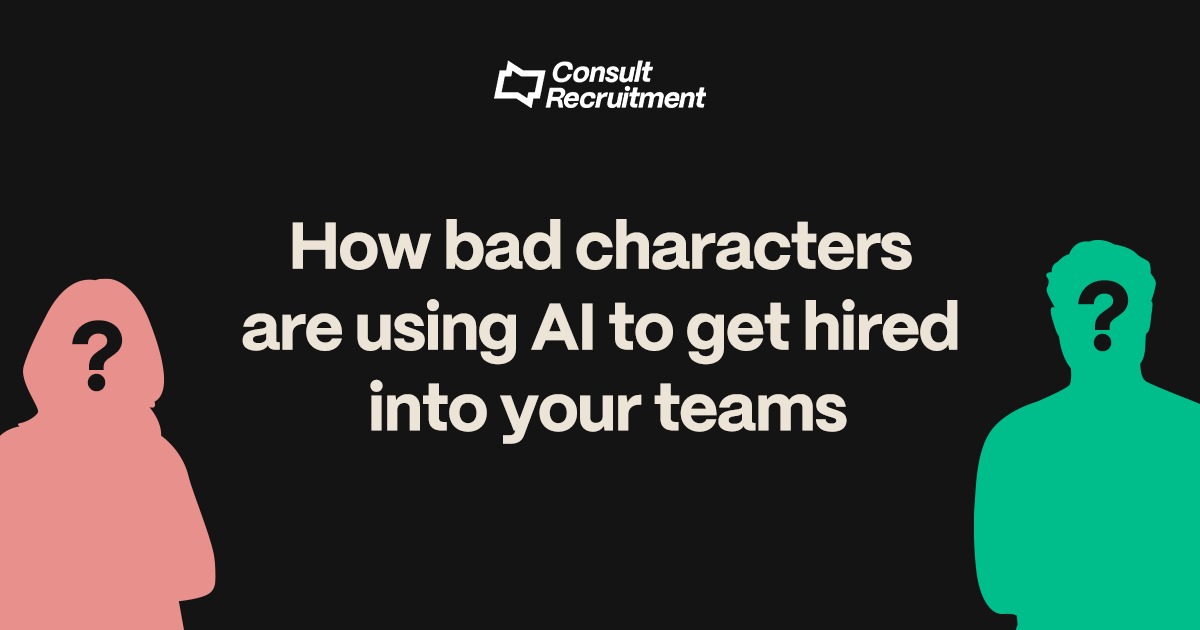
How bad characters are using AI to get hired into your teams
A few weeks ago, we attended an event run by Pete Hooper and the team at Checkmate, featuring a guest speaker Anton Watson – a London-based background checking and vetting expert who advises financial organisations on how to maintain best practise for background checks.
The topic? How AI is reshaping the background check conversation.
Nobody wants to hire a ‘bad character’. But many want to be hired by you – and increasingly, they are using AI to enable that to happen. The topic was fascinating (and slightly concerning!).
The reality is, whether it’s organised crime trying to infiltrate financial services organisations, or just individuals with a bad employment history, there are very strong motivators for people to use AI for nefarious reasons.
Here are 5 ways these bad characters are using AI to get hired:
1. Using AI to create resumes.
AI is being used to create entire job histories (fake roles, often fake companies and fake achievements). These resumes often have ‘keyword stuffing’ – these are specific words which an employer’s ATS uses to screen candidates in (and out). In this case, because the ‘right words’ are on the resume, the candidate will make it through the ATS screening process – ready for the next stage in recruitment deception!
2. Using AI to create fake qualifications and rights to employment.
With not much effort or knowledge, you can become a doctor, a lawyer or an accountant (on a fake certificate also generated by AI). Impersonation is easy too with fake work visas and drivers licenses. You can even get a fake bank statement to prove your income and address. Unlike previously, where fakes were pretty easy to spot, now using AI, these fakes are sophisticated and hard to spot.
3. There are organisations that (for a fee) will create fake companies for the fake role you ‘had’ and even give fake references to a potential employer.
“(Company name) has developed nearly 100 registered company websites where calls are answered in company, and emails are from company domain names. This offers you unparalleled success in employment verification from third party background screening companies.”
So as an employer, you might call the ‘referee’ for a candidate, only to go through to a call centre, where you will speak with someone who will give a glowing endorsement of the candidate’s fake role in the fake company. Scary much?!
4. Online interviews are becoming more risky.
While online interviews are easy and convenient (especially with location differences), there is now AI that can sit alongside the online meeting and ‘assist’ the candidate. AI will listen to your questions and give the candidate an excellent scripted answer. While some of these answers are not overly sophisticated, it is only a matter of time before they become excellent. The risk we run is that in an online forum, you really won’t know if the answer given is a genuine answer.
And while we are on the topic of online interviews: real-time avatars using voice alteration tools mean applicants can modify their appearance and voice to match a different identity. This means the candidate you are interviewing online might be someone else who is using AI to alter their appearance in order to get the job for another person. For roles in remote locations, this is becoming an increasing problem.
5. Creating fake LinkedIn profiles.
While LinkedIn is such an amazing tool in many regards, the downside is you can be anyone on LinkedIn. Previously, you could say you’ve worked anywhere, in any role and with any qualification and there is no vetting of this. We are now seeing a rise of deepfake LinkedIn profiles. These profiles show a strong online presence, job histories and networks that definitely look real at first glance.
So what are the “red flags” to look out for, and how do you protect your organisation and your team from hiring a fake?
Great question and one that we have answered in our next post: How to protect your business from hiring an AI imposter.
For more tips on how to effectively hire and be hired in this fast moving environment, sign up to our newsletter or follow us on LinkedIn here (promise it’s really us!), or get in touch with us at info@consult.co.nz.

